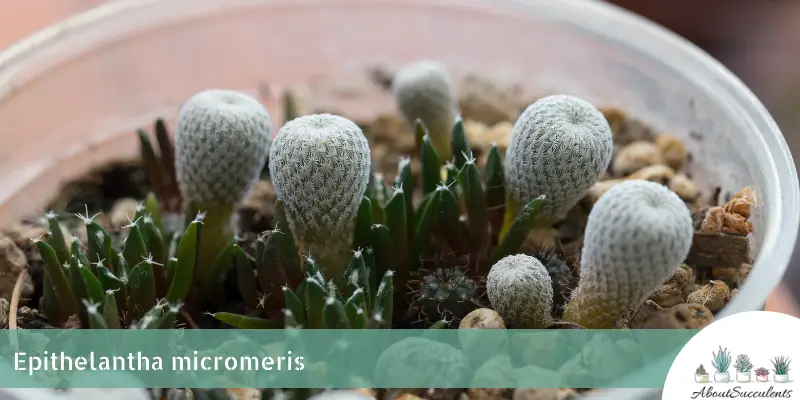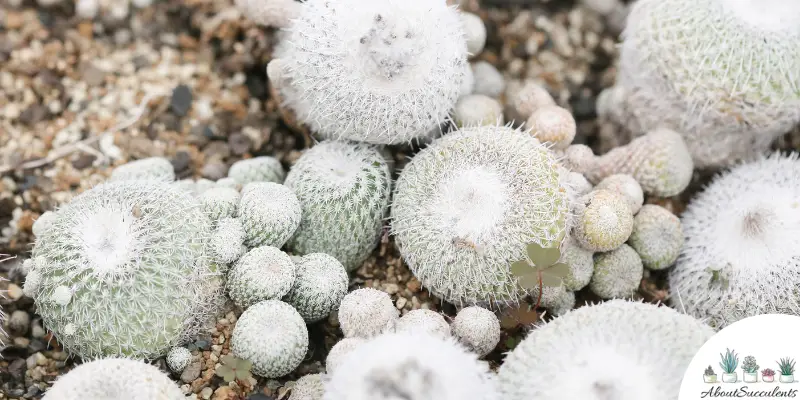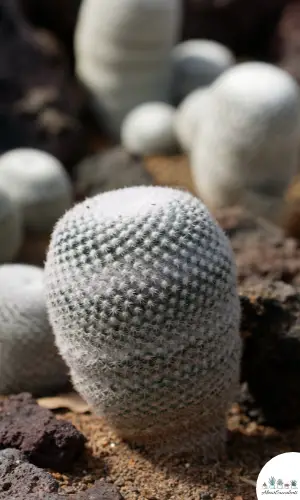
Epithelantha micromeris will elicit comments such as “odd”, “strange”, and “weird” but in a nice way. Affectionately called, “Button Cactus”, this cute and charming succulent can grace your rock garden or liven up your living room.
Button Cactus starts out as a small shrub but grows up to a height of 12-inches (30.5cm) and spreads out to 36-inches (91cm) in diameter.
This cactus has a dark green color and is covered by many tiny, grayish-white radial spikes. In fact, the surface is riddled with hundreds of spikes that you can only see a portion of the succulent’s body.
In the late winter to early spring, Epithelantha micromeris will bloom small, pinkish-white flowers that are reportedly the smallest among Cacti. The flowers bear bright-red, cylindrical fruits with black seeds. The fruits are edible.
Epithelania micromeris is part of the Cactaceae family and is native to Madagascar. Its other nickname is Pingpong Ball Cactus.
General Information
Also known as: Button Cactus. Pinpong Ball Cactus
Plant Family: Cactaceae
Origin: Madagascar
Height: 12-inches (30.5cm)
Exposure: Full to partial sun for up to 8 hours per day
Water Needs: Drought-tolerant; use the “Soak and Dry” method where the soil is given a thorough drenching only after it has been tested to be 100% stone dry
Soil Type: Cactus or a succulent soil mix with added gritty ingredients such as coarse sand for improved drainage
Soil pH: 5.8
How to Grow and Care for Epithelantha Micromeris

Epithelantha micromeris can be arranged as potted succulents or in hanging baskets to brighten your outdoor garden or patio.
They are small cacti and will stand out when placed on shelves in your office, kitchen, and dining room. You might have come across Button Cactus in the powder rooms of hotels or as table accents at a wedding.
Aside from causing your guests to say “awwww…”, another reason why Pingpong Ball Cactus is popular is that it’s easy to grow and care for.
Sunlight
Similar to other species of succulents that thrive when given enough sunlight, Epithelantha micromeris enjoys more sun than everyone else.
Succulents generally do well when given up to 6 hours of partial to full sun exposure. But Pingpong Ball Cactus grows better when given up to 8 hours of sun and direct exposure at that.
As an outdoor succulent, plant Epithelantha micromeris in a location in the garden that gets up to 8 hours of sunlight. You can grow Button Cactus in a container and let it have 4 to 6 hours of direct sunlight before moving it to partial shade.
Planting Button Cactus in a pot will be recommended if temperatures in your area fall below 20° F (-6.7° C) because this isn’t a cold-hardy succulent.
When the frosty months come in, move Pingpong Ball Cactus indoors for safety. Make sure the cactus still gets its daily dose of the sun’s rays by positioning it near a window that gets at least 4 hours of partial sunlight.
To be sure, Epithelantha micromeris is happy indoors, place it under a Grow Light for 6 to 8 hours every day.
Watering

Cacti are known to survive drought conditions where they don’t get any water for weeks. Epilantha micromeris prefers fewer watering schedules to keep its roots safe from rotting.
Thus, if you left for a 2-week vacation and forgot to water Button Cactus, don’t sweat it. Your succulent will be healthy and well when you get back.
Don’t water the soil until you’ve tested its level of dryness. The rule is the soil must be 100% dry before giving it water. You can easily do this by inserting a finger or a stick into the soil.
Pull it out and check the end of the stick. If you’re convinced that the stick is dry, go ahead and give the soil a good soaking. Always water the soil and never the plant.
Expect to water the soil more frequently – around every seven to 10 days – in the summertime. When winter rolls in, you won’t water as much – maybe once a month – because soil retains moisture longer.
Pot and Soil
Drainage remains your top priority when shopping for Button Cactus’s pot and soil. Unglazed ceramic and terracotta pots are your best options because these materials support soil aeration and make it easier for moisture to escape.
The pot should be 10% to 20% larger than the base of the succulent to prevent the roots from getting tangled up and to allow air to flow through properly. Similarly, getting a pot that’s too big for Button Cactus will be harmful because more soil means it might take longer to dry out.
For soil, choose a fast-draining variety such as a cactus mix. Add gritty materials such as coarse sand, perlite, and pumice to further improve drainage.
How to Propagate Epithelantha Micromeris
Sure, you can always head off to the nearest nursery to buy another succulent. But where’s the fun in that? Propagating Epithelantha micromeris is a fun learning experience that you can share with your kids.
There are 2 methods to choose from – Offsets and seeds. Propagating from either method can result in success but seeds might be a bit more tricky because these are sensitive to changes in temperature.
Offsets Method
Step 1: You can gently pull out the offsets that are growing near the base of Button Cactus or use a sterilized and sharpened knife to cut off obstructions to a clean pull.
Step 2: Allow the offsets 2 to 4 days to dry out and develop calluses.
Step 3: Plant the offsets on a bed of well-draining soil. Lightly water the soil and place it near a window that gets partial sunlight.
Step 4: Check the soil from time to time. Once the roots have formed, only water the soil when it’s 100% dry.
Seeds Method
Step 1: You can harvest the seeds that are produced by the fruits of Epithelania micromeris. Planting the seeds outdoors is possible if you live in a region where the temperature averages 20° F to 25° F (-6.7° C to -3.8° C ) or under USDA zone 9A. If the temperatures get colder, it would be best to propagate via seed indoors.
Step 2: Plant the seeds in well-draining soil. Water the soil lightly and cover it with plastic. Place the pot near an area that receives partial sunlight. It might take a few days for germination to take place.
Step 3: Remove the plastic once the roots have taken hold and water the soil only when it’s completely dry.
Frequently Asked Questions
Is Epithelantha Micromeris Toxic To Cats and Dogs?
Epithelantha micromeris isn’t included in the list of plants toxic to cats and dogs that appear on the website of the American Society for the Prevention of Cruelty to Animals (ASPCA).
Why Is My Epithelantha Micromeris Dying?
Epithelantha micromeris as a member of the cacti family is durable but it remains vulnerable to root rot and pests.
If Pingpong Ball cactus is getting weak or dying it could be because of overwatering or that pests have taken control. You can still save your succulent by following our tips below.
Overwatering
Overwatering is the number one cause of death of succulents. If you keep watering the soil even though there’s still moisture, it will cultivate bacteria.
The roots that have remained immersed in moist conditions will rupture and start rotting. The fungi that have been growing in the soil will enter the plant through the rotted roots.
You’ll know this to be the case when you see the cactus developing brownish, yellowish, or even blackish spots. Act immediately and cut off the infected sections with a sterilized knife to prevent the infection from spreading.
Remove Button Cactus from the pot and cut out all of the rotted roots. Let the succulent dry out for a few days. Meanwhile, prepare a new pot and fill it up with cactus mix and gritty materials.
Replant Button Cactus and give it a few days to get used to the new environment before watering the soil.
Pest Infestation
Mealybugs and nematodes are attracted to Pingpong Ball Cactus because of its sap. Get rid of these pests before they drain your succulent of sap which provides the plant with nutrition.
You can spray the plant with 70% isopropyl alcohol or diluted neem oil. If you notice white substances on Button Cactus, remove these right away with a Q-tip soaked in the alcohol.
Yes, Epithelantha micromeris produces small, cylindrical, pinkish-white flowers with edible fruits in the late winter to early spring.
Last Updated on June 9, 2022 by Sofia Lara